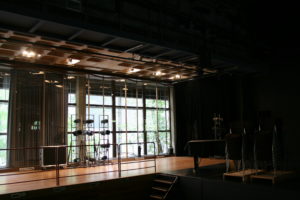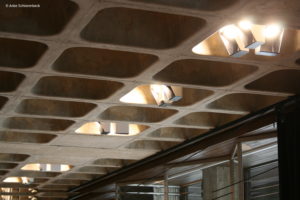Global Design Solutions-Art of control – UdK Berlin
Posted by Global Design Solutions Ltd on 21st June 2019 -

The Berlin University of the Arts (UdK Berlin) is the largest art school in Europe and is attended by more than 3,500 students. Teaching is offered mostly in traditional formats in four colleges: Fine Arts; Architecture; Media and Design; and Music and Performing Arts. Classes are also offered at the Central Institute for Continued Education/Berlin Career College. The university covers the full spectrum of the arts, and related academic studies, with more than 70 courses.
UdK Berlin is also an important cultural hub in the city and stages more than 700 events each year. Built between 1971 and 1975 and designed by Paul Baumgarten, UNI.T, the university’s 330-seat theater and rehearsal room, is a listed building where education in every aspect of theater-related professions takes center stage.
Time to upgrade
The auditorium’s lighting was neither energy-efficient nor performing to the standards expected of a contemporary theater, and UdK Berlin was keen to upgrade it. The listed status of the building presented a number of challenges to the project and UdK Berlin’s technical team and its consultants, itv engineering company for theater and event technology, reached out to lighting specialist and distributor VisionTwo. As a heritage site, UNI.T’s status severely restricted the extent to which its infrastructure and aesthetic could be altered.
“In keeping with conservation requirements, the brief was to keep the lighting fixtures as they existed, but it was very important to retrofit to LED,” says Felix Wolf, technical director of events at UdK. “We wanted excellent light quality and perfect dimming, and to save energy, money and reduce maintenance. It was also essential that the solution used the existing cabling that was contained within the building’s structure.
To replace it would be very complicated and simply not practical.”
VisionTwo, in turn, reached out to LED specialist Global Design Solutions (GDS), to help determine the best approach. It was immediately obvious that the ingenuity of its Special Projects team would be tested by UNI.T’s 1970s setting. Ultimately, the project demonstrated the great talents of that team, which overcame the challenges with the deployment of a world first in the shape of its DX driver technology.

Saving existing fixtures
The upgrade required that the existing halogen fixtures be retained, refurbished and retrofitted with LED lamps and that new fixtures were created from scratch to seamlessly replicate them.
On top of that, the fact that the building’s cabling was inlaid into its concrete infrastructure meant that it couldn’t easily be replaced. UdK had ruled out a wireless system from the outset, so the need to use the existing cabling created a serious challenge. The task required the team not only to apply its creative skills to the fittings, but also to ensure that, crucially, the fittings could be controlled via the existing cables to dim perfectly.
The GDS Special Projects team, spearheaded by Richard Dyer, head of production, and working in close collaboration with experienced system integrators Amptown System Company (ASC) and VisionTwo’s lighting specialists, set about meeting the challenges.
The GDS team carried out an LED retrofit upgrade for two fittings and a brand-new product design for another. The new product was made to look exactly like the 1970s original and was more cost effective than a retrofit. In all, 148 new and refurbished pieces were created, each fitted with a unique ArcSystem Pro One-Cell Small unit and reinstated in UNI.T.
The project was on a tight schedule throughout and, remarkably, it took the GDS Special Projects team less than four weeks from the disassembling of the fixtures to returning both these and the new products for installation.
“From a technical standpoint, this was a fantastic project to be involved with,” comments Dyer. “It was great to work with the existing 1970s fixtures and upgrade them into modern eco-friendly versions without affecting their appearance. Time wasn’t really on our side and it meant the team drawing on every ounce of our experience and creativity.”
The second aspect of the job saw GDS address the difficulties posed by the need to use the existing cabling. The Special Projects team regularly met similar problems in other theaters and had been developing technology to overcome these issues.
Dyer, together with GDS’s head of research and development, Adam Cooper, had utilized lessons learned previously to formulate the DX driver and to provide control over a GDS-developed proprietary protocol, as well as powering the luminaires through existing cabling. This brand-new driver system still guaranteed the perfect dimming for which ArcSystem is renowned. When VisionTwo presented GDS with the brief, it was evident that UNI.T was a prime candidate for the application of this groundbreaking technology.
“Overcoming the problem of using the existing cabling through introducing new technology was exciting and satisfying in equal measures,” says Dyer. “The driving technology enables the use of the existing cabling for dimmable products and, being modular, has excellent serviceability in that the driver cards and power supplies can easily be removed and replaced. The overall result looks amazing – it’s an elegant solution that has future-proofed UNI.T for years to come. The conservation specialists and technical director are extremely happy with the results.”
Smooth launch
GDS support and applications engineer John Blamey attended the install, commissioned the site, and assisted ASC project manager Jan Vandrei and his team with the wiring of the drivers and dedicated power supplies. Blamey initiated the first system power-up – invariably leading to a moment of suspense – and to the delight of everyone involved, witnessed everything working perfectly from the off.
“Everyone worked really well together,” says Anke Schierenbeck, key account manager at VisionTwo. “The GDS team are inspiring people with such great ideas and worked with us on the fly to find solutions.
As well as the idea to rebuild and make new versions of the protected fixtures, GDS developed the DX system to solve the problems of control and dimming and it was very rewarding to be a part of helping to deliver this unique solution. Having the GDS Special Projects team in attendance helped to complete an extremely complicated project, on time and, most importantly, to the absolute satisfaction of our customer.”
“The aims of the project were all achieved,” says Wolf. “I commend all the partners on their great work. The system is working very well and we don’t have any issues at all, which is exactly what we wanted.”





